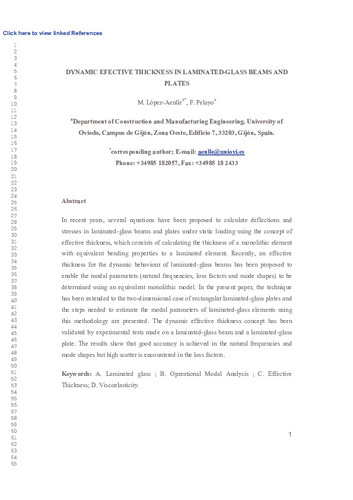Dynamic effective thickness in laminated-glass beams and plates
Autor(es) y otros:
Palabra(s) clave:
Laminates
Operational modal analysis
Viscoelasticity
Mechanical testing
Fecha de publicación:
Editorial:
Elsevier
Versión del editor:
Citación:
Descripción física:
Resumen:
In recent years, several equations have been proposed to calculate deflections and stresses in laminated-glass beams and plates under static loading using the concept of effective thickness, which consists of calculating the thickness of a monolithic element with equivalent bending properties to a laminated element. Recently, an effective thickness for the dynamic behavior of laminated-glass beams has been proposed to enable the modal parameters (natural frequencies, loss factors and mode shapes) to be determined using an equivalent monolithic model. In the present paper, the technique has been extended to the two-dimensional case of rectangular laminated-glass plates and the steps needed to estimate the modal parameters of laminated-glass elements using this methodology are presented. The dynamic effective thickness concept has been validated by experimental tests made on a laminated-glass beam and a laminated-glass plate. The results show that good accuracy is achieved in the natural frequencies and mode shapes but high scatter is encountered in the loss factors
In recent years, several equations have been proposed to calculate deflections and stresses in laminated-glass beams and plates under static loading using the concept of effective thickness, which consists of calculating the thickness of a monolithic element with equivalent bending properties to a laminated element. Recently, an effective thickness for the dynamic behavior of laminated-glass beams has been proposed to enable the modal parameters (natural frequencies, loss factors and mode shapes) to be determined using an equivalent monolithic model. In the present paper, the technique has been extended to the two-dimensional case of rectangular laminated-glass plates and the steps needed to estimate the modal parameters of laminated-glass elements using this methodology are presented. The dynamic effective thickness concept has been validated by experimental tests made on a laminated-glass beam and a laminated-glass plate. The results show that good accuracy is achieved in the natural frequencies and mode shapes but high scatter is encountered in the loss factors
ISSN:
Patrocinado por:
The economic support given by the Spanish Ministry of Education through the Project BIA2011-28380-C02-01 is gratefully appreciated
Colecciones
- Artículos [37556]
- Construcción e Ingeniería de Fabricación [508]
- Investigaciones y Documentos OpenAIRE [8424]
Ficheros en el ítem





